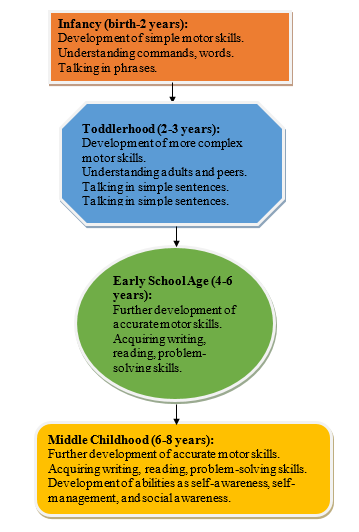Introduction
Childhood development can be divided into a number of stages. Thus, the development from birth to 8 years old can be divided into 4 major stages (Newman and Newman 67). These stages are infancy, toddlerhood, early school age, and middle childhood (see fig. 1). During these stages, children go through cognition, physical, social/emotional, creative development. Importantly, there are certain standards and educators have to pay attention to them (“NAEYC Standards for Early Childhood Professional Preparation Programs” 11).

During infancy, children learn how to move their bodies and, by the age of 2, they can usually walk. Major and minor motor skills are developing. Infants can grab, throw and hold things. They can also catch some objects. By 2 years old, infants understand adults and react to their words. Infants also start talking using simple sentences and phrases. They also play with their toys and can copy actions in familiar settings (Shaffer & Kipp 206). Infants also play with their peers, share toys, and so on. They also start acquiring problem-solving skills, of course, with the help of their parents (Petersen 12).
Main body
During toddlerhood, children continue developing major and minor motor skills. They can run, hop, jump, hold and catch big and small things (balls, toys, pencils, and so on) and so on. They also continue developing their problem-solving skills but they still need the assistance of their parents (Petersen 12). They comprehend adults and their peers. When speaking, they use sentences as their vocabulary increases. They also develop their social skills as they communicate with their peers and play together (Shaffer & Kipp 213). Toddlers’ creative development can be traced through their drawings (or mainly coloring drawings).
During early school age, children become more accurate and more integrated socially. As for physical development, children become more skillful. They can run, jump, hop, copy movements of adults with significant precision. They can also write, draw, use scissors, and so on. Importantly, depression and poor psychological and emotional state can slow down the development of motor skills (Piek et al. 143).
As for cognitive development, children at this stage continue improving their vocabulary and they use sentences that are more complex. They can read and write simple words (numbers) and sentences. They can count. Their drawings become more accurate. Their creative development can be traced through their drawings that can include some stories rather than simple objects. Their games also become more deliberate. They also continue developing their social skills when they play with their peers or interact with adults. They can follow the rules of games with significant precision. Of course, they often need the guidance of adults.
Conclusion
During middle childhood, children continue developing their major and minor motor skills. Their movements become precise and accurate. They can read, write, count. Their speech is quite complex. Their attention span also increases. They can retell and make out stories. Their creative development can be traced through their drawings, stories they tell, games they play. At this stage, children’s social development is one of the most important types of development.
Children develop such abilities as self-awareness, self-management, and social awareness (Lantieri and Nambiar 29). Of course, parents and teachers should help children develop proper social skills. Thus, as for social development, children interact with adults and peers in many settings and many ways. Children play games following particular rules and they can create their own games with their rules.
Works Cited
Lantieri, Linda and Madhavi Nambiar. “Cultivating the Social, Emotional, and Inner Lives of Children and Teachers.” Reclaiming Children and Youth 21.2 (2012): 27-33. Print.
NAEYC Standards for Early Childhood Professional Preparation Programs. 2009. Web.
Newman, Barbara and Phillip Newman. Development Through Life: A Psychological Approach. Belmont: Cengage Learning, 2011. Print.
Petersen, Sandra. “School Readiness for Infants and Toddlers? Really? Yes, Really!” Young CHildren (2012): 10-13. Print.
Piek, Jan P., Greer S. Bradbury, Sharon C. Elsley and Lucinda Tate. “Motor Coordination and Social–Emotional Behavior in Preschool-aged Children.” International Journal of Disability, Development and Education 55.2 (2008): 143-151. Print.
Shaffer, David and Katherine Kipp. Developmental Psychology: Childhood and Adolescence. Belmont: Cengage Learning, 2013. Print.